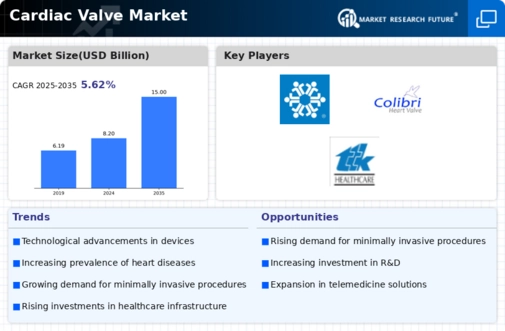Market Trends
Key Emerging Trends in the Cardiac Valve Market
Due to heart health care advances, an aging population, and more awareness of valve issues, the cardiac valve industry is evolving. Here are the top business trends in cardiac valves: TAVR is less invasive than open-heart operations, making it a preferred aortic valve disease treatment. New valve design and delivery technologies enable this development. These technologies allow catheter-based valve replacement, speeding patient healing. Bioprosthetic valves manufactured from cattle or pig tissues are becoming more popular. These valves are beneficial for some patients since they have a more natural hemodynamic profile and don't require long-term anticoagulation. Bioprosthetic valves are popular because they endure and reduce clotting. Minimally invasive valve repairs like percutaneous mitral valve surgery are becoming more common. These approaches repair the valve instead of replacing it. This reduces invasiveness and improves patient outcomes. New imaging and interventional cardiology tools allow for less invasive valve repairs. Research is ongoing to create heart valves that are more durable, survive longer, and operate better with the body. New technologies like tissue engineering and sophisticated polymers are making valves that work like natural valves. This fixes existing artificial valve issues. Customized heart valve transplants are becoming more common. Customizing prosthetic valve shapes and sizes to each patient improves fit and function. Customised solutions increase patient outcomes and reduce valve implant issues. Improved child heart valves are being created. Prosthetic valves for congenital heart disease are improving to live longer and adapt to children's demands. This trend addresses pediatric cardiology's unique issues and improves long-term outcomes. Heart valve therapies are becoming more precise and accurate using 3D echocardiography and cardiac MRI. Real-time imaging lets doctors evaluate valves and treatments, making them safer and more successful.
In the heart valve sector, regulatory permits are crucial. Manufacturers must undergo rigorous approval processes to meet regulators' safety and efficacy demands. Following the rules allows new and better heart valve technology to market. This promotes innovation and patient safety. Making valve-fixing equipment so patients can use their native valve is becoming increasingly popular. Mitral valve repair valves may improve long-term outcomes, reduce the requirement for lifelong anticoagulation, and work more naturally. The global cardiac valve market is rising because more individuals are having heart illnesses and emerging nations can afford better health care. Companies are looking for business in several areas and changing their products to satisfy the needs of diverse patient groups.







Leave a Comment